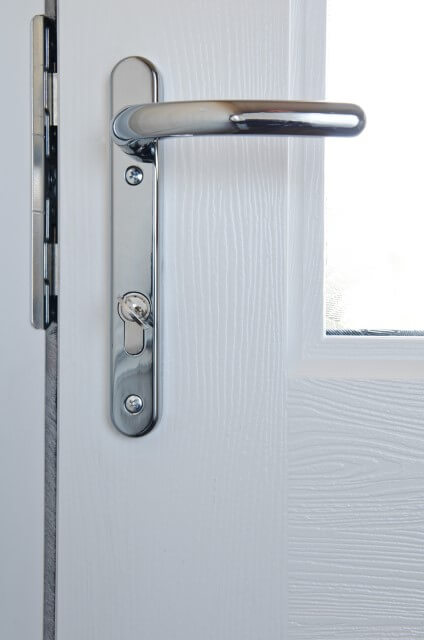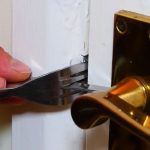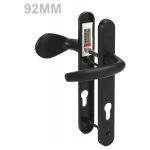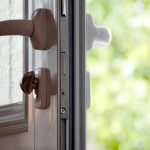
My uPVC Door Wont Open – What To Do
If you have a uPVC door that won’t open, you may find yourself frustrated and unsure of what to do next. This can be a common issue with uPVC doors, but fortunately, there are steps you can take to try and resolve the problem.
Firstly, it’s important to remain calm and not panic. There are several reasons why your uPVC door may not be opening, and it’s often a simple fix rather than a major issue. Take a moment to assess the situation and consider any recent changes or events that may have led to the problem.
One common cause of a uPVC door not opening is a faulty lock or mechanism. This can occur if the lock has become jammed or stuck, preventing the door from opening. In this case, you may need to call a professional locksmith to help resolve the issue. They will have the tools and expertise to assess the lock and determine the best course of action.
Alternatively, if your uPVC door won’t open due to a misaligned or stuck door frame, there are a few steps you can try yourself. First, check for any visible obstructions such as debris or dirt that may be preventing the door from sliding smoothly. If necessary, use a brush or vacuum cleaner to remove any debris. You can also try using a lubricant, such as WD-40, to help loosen the door frame and make it easier to open.
In conclusion, if your uPVC door won’t open, it’s important not to panic. Assess the situation calmly and consider calling a professional locksmith if necessary. Alternatively, try checking for any visible obstructions or using a lubricant to help loosen the door frame. By following these expert tips, you can hopefully resolve the issue and get your uPVC door open once again.
Reasons Why Your uPVC Door Won’t Open
If your uPVC door won’t open, it can be quite frustrating and inconvenient. Here are some possible reasons why this may be happening:
- Misalignment: One of the most common reasons for a uPVC door to not open is misalignment. Over time, the door frame or hinges can shift, causing the door to become misaligned and difficult to open. In this case, you may need to adjust the door or call a professional to realign it.
- Sticking Lock Mechanism: If the lock mechanism is sticking, it can prevent the door from opening. This can be caused by dirt, debris, or lack of lubrication. Try cleaning the lock mechanism and applying some lubricant to see if it helps. If not, you may need to have the lock mechanism repaired or replaced.
- Warped Door: uPVC doors can warp over time due to changes in temperature and humidity. If your door is warped, it may be difficult or impossible to open. In this case, you may need to have the door repaired or replaced.
- Faulty Handle or Cylinder: If the door handle or cylinder is faulty, it can prevent the door from opening. Check to see if the handle or cylinder is loose or damaged. If so, you may need to replace them.
- Security Feature: Some uPVC doors have additional security features that can prevent the door from opening. Make sure you are using the correct key or code to unlock the door, and check if there are any additional locks or latches that need to be released.
If none of these reasons seem to apply or if you are unsure about how to fix the problem, it is best to contact a professional uPVC door repair service. They will be able to accurately diagnose the issue and provide the necessary repairs to get your door open again.
Remember, attempting to force open a uPVC door can cause further damage, so it is important to address the issue properly and safely.
Expert Tips to Fix a Stuck uPVC Door
If your uPVC door is not opening, it can be quite frustrating. However, there are a few things you can do to try and fix the issue before calling for professional help.
1. Check the lock mechanism: Start by checking the lock mechanism on your uPVC door. Make sure it is properly aligned and not damaged. Sometimes, a misaligned or damaged lock can prevent the door from opening.
2. Lubricate the lock and hinges: Over time, the lock and hinges of a uPVC door can become stiff and difficult to operate. Use a silicone-based lubricant to grease the lock and hinges, which should make them easier to move and potentially fix the issue.
3. Use gentle force: If the door is stuck, try applying gentle pressure to see if it will give. However, be careful not to use excessive force as this could damage the door or lock mechanism further.
4. Check the weather seals: Weather seals are strips of rubber that prevent draughts and water from entering your home. If the weather seals are damaged or worn out, they can obstruct the movement of the door. Inspect the weather seals and replace them if necessary.
5. Seek professional help: If you have tried the above tips and your uPVC door still won’t open, it’s best to seek professional help. A skilled locksmith or uPVC door specialist will have the necessary tools and expertise to diagnose and fix the issue.
Remember, if you are not confident in your abilities to fix the problem, it’s always best to consult a professional to avoid causing further damage.
Check for Obstructions
If your uPVC door won’t open, the first thing you should do is check for any obstructions that may be preventing it from opening. This can include objects blocking the doorway, such as furniture or plants, or any debris that may have gotten stuck in the door mechanism.
Start by inspecting the area around the door to see if there are any objects in the way. If there are, move them to clear the path and try opening the door again. If this doesn’t solve the problem, you may need to take a closer look at the door mechanism.
Inspect the door hinges and handle to ensure they are not damaged or obstructed. Sometimes, loose screws or misaligned hinges can prevent the door from opening properly. Tighten any loose screws and realign any misaligned parts to see if that solves the issue.
If the door still won’t open, you may need to examine the lock mechanism. Check if the lock is engaged and if the key is turning smoothly. Lubricating the lock with a small amount of graphite powder or silicone spray can help if it’s sticking. If the lock is damaged or not functioning properly, you may need to call a professional locksmith for assistance.
Remember, when dealing with a uPVC door that won’t open, it’s important to be patient and avoid forcing the door open. Applying excessive force can cause further damage and make the problem more difficult to fix. With a little bit of troubleshooting and perhaps some professional help, you will be able to resolve the issue and have your uPVC door working properly again.
Examine the Lock Mechanism
If your uPVC door won’t open, one of the primary areas to investigate is the lock mechanism. The lock may be jammed or faulty, preventing the door from unlocking properly. Here’s what you can do:
- Check if the key turns smoothly in the lock. If it doesn’t, there might be something stuck or broken within the lock mechanism.
- Inspect the alignment of the lock with the strike plate. If they are misaligned, it could cause difficulty in turning the key or opening the door.
- Ensure the lock barrel is clean and free from any debris or dirt. Use a lubricant specifically designed for locks to clean and lubricate the barrel.
- Try gently pushing or pulling the door while attempting to unlock it. Sometimes, the pressure can help release any tension or obstructions in the lock mechanism.
- If you have a multipoint lock system, make sure all the locking points are fully disengaged. Check the handles, bolts, and hooks to ensure they are in their correct positions and not obstructing the door’s movement.
- Consider seeking professional help if you’re unable to identify or fix the issue yourself. A locksmith or uPVC door specialist can assess the lock mechanism and provide the necessary repairs or replacements.
By examining the lock mechanism and following these steps, you can troubleshoot and resolve issues with your uPVC door that won’t open.
Inspect the Door Hinges
If your uPVC door won’t open, one of the possible reasons could be a problem with the door hinges. Over time, the hinges may become loose or damaged, preventing the door from opening properly.
To inspect the door hinges, start by checking if they are securely attached to both the door and the frame. Look for any visible signs of damage, such as cracks or misalignment. If you notice any issues with the hinges, it may be necessary to tighten the screws or replace the damaged hinges.
Additionally, make sure that the hinges are properly lubricated. Lack of lubrication can cause friction and make it difficult to open the door. Apply a small amount of lubricant, such as silicone spray, to the hinge pins and moving parts of the hinges.
If the door hinges appear to be in good condition and properly lubricated, but the door still won’t open, it’s recommended to seek professional help. A locksmith or a uPVC door specialist will have the expertise to diagnose and fix any complex issues that may be causing the door to remain closed.
Assess the Weatherstripping
One possible reason why your uPVC door won’t open is that the weatherstripping may be causing too much friction. The weatherstripping, which is the rubber strip located around the edges of the door, is designed to seal off any gaps and prevent drafts. However, over time, this strip can become worn out or damaged, causing it to create too much resistance when trying to open the door.
To assess the condition of the weatherstripping, visually inspect it for any signs of wear or damage. Look for cracks, tears, or areas where it may be peeling away from the door frame. If you notice any of these issues, it may be time to replace the weatherstripping.
If the weatherstripping appears to be in good condition, try running your hand along the edge of the door to feel for any rough or sticky spots. This can indicate that there is excess friction caused by the weatherstripping. To address this, you can use a silicone-based lubricant specifically designed for uPVC doors. Apply the lubricant to the weatherstripping and then open and close the door several times to help distribute the lubricant evenly.
If the door still won’t open after assessing and addressing the weatherstripping, it is recommended to consult a professional uPVC door repair specialist. They will have the expertise and tools necessary to diagnose and fix the issue.
Consider the Door Alignment
If your uPVC door won’t open, it could be due to misalignment. Over time, the door may shift or settle, causing it to be misaligned with the door frame. This can result in difficulty opening or closing the door properly.
To determine if misalignment is the issue, visually inspect the door and frame. Look for any gaps or overlaps between the door and frame. Additionally, check if the door is flush with the frame or if it sits at an angle.
If you notice any misalignment, there are a few steps you can take to address the issue. First, check the hinges. Loose or damaged hinges can contribute to misalignment. Tighten any loose screws and replace any damaged hinges.
Next, verify that the door is properly installed in the frame. If the door is not aligned correctly, you may need to remove it and reinstall it. Make sure all screws and fixings are tightened securely.
If the misalignment persists, it may be necessary to adjust the door frame. This should be done by a professional to avoid causing further damage.
By considering the door alignment and taking appropriate action, you can resolve the issue of a uPVC door that won’t open.
Look for Faulty Door Handles
If your uPVC door won’t open, one of the potential culprits could be faulty door handles. Over time, door handles can become worn or damaged, making it difficult or impossible to open the door.
Start by examining the door handles closely. Look for any visible signs of damage or wear, such as cracks, chips, or loose screws. Make sure the handles are securely attached to the door and that there is no excessive play or movement.
If you notice any problems with the handles, you may need to replace them. Check with the manufacturer of your door to find out if they offer replacement handles or if there are any specific recommendations on where to purchase compatible replacements.
Replacing the door handles is typically a straightforward process. You will likely need to remove a few screws to detach the old handles and then attach the new ones in their place. Follow the manufacturer’s instructions for the specific installation process.
Once you have replaced the door handles, test the door to see if it opens properly. If the handles were indeed the issue, the door should now open smoothly. If the problem persists, you may need to consider other potential causes, such as a faulty lock or misaligned hinges.
Remember, if you’re unsure about how to proceed or if you’re having difficulty identifying the problem, it’s always best to consult with a professional uPVC door technician. They will have the expertise and knowledge to quickly diagnose and fix any issues with your door.
Check the Key Cylinder
If your uPVC door won’t open, one of the first things you should check is the key cylinder. Sometimes, the problem can be as simple as a malfunctioning key or a cylinder that needs lubrication. Here’s what you can do to diagnose and fix the issue:

- Inspect the key: Take a close look at your key and make sure it’s not damaged or bent. If it is, you may need to get a new key made.
- Try a different key: If you have a spare key, give it a try. If the door opens with the spare key, then the problem is likely with your original key.
- Lubricate the cylinder: Use a silicone-based lubricant to lubricate the key cylinder. Insert the key and turn it several times to distribute the lubricant. This can help loosen any debris or rust that may be causing the issue.
- Clean the key cylinder: If lubrication doesn’t solve the problem, the cylinder may be dirty or clogged with debris. Use a can of compressed air or a small brush to clean out any dirt or debris that may be blocking the cylinder.
- Call a professional: If none of the above steps resolve the issue and your uPVC door still won’t open, it’s time to call a professional locksmith or uPVC door specialist. They will have the expertise and tools to diagnose and fix the problem.
Remember, it’s always best to consult a professional if you’re unsure about what to do or if you’re not comfortable with DIY repairs. They can help you avoid causing any further damage to your uPVC door.
Test the Door Frame
If your uPVC door won’t open, one possible issue could be with the door frame. Over time, the frame may become misaligned or warped, preventing the door from opening smoothly.
To test the door frame, start by examining it visually for any obvious signs of damage or misalignment. Look for gaps between the door and the frame, or any parts of the frame that appear to be bent or twisted.
If you notice any visible issues, try gently pushing or pulling on the door to see if it moves or if it feels stuck. Be careful not to use excessive force, as this could cause further damage.
If the door is stuck in the closed position, you can also try using a lubricant on the hinges to see if this helps. Apply a small amount of lubricant and then attempt to open the door again.
If you’re still unable to open the door, it’s recommended to contact a professional uPVC door repair specialist. They will have the expertise and tools needed to diagnose and fix the issue with your door frame.
Key points to remember:
- Visually inspect the door frame for signs of damage or misalignment.
- Try pushing or pulling on the door to see if it moves or feels stuck.
- Apply lubricant to the hinges if the door is stuck in the closed position.
- Contact a professional if you’re unable to open the door.
By testing the door frame and addressing any issues, you can increase the chances of successfully opening your uPVC door.
Inspect the Door Frame for Warping
If your uPVC door won’t open, one possible cause could be a warped door frame. Over time, changes in temperature and humidity can cause the uPVC material to expand and contract, leading to warping.
To inspect the door frame for warping, follow these steps:
- Start by examining the area around the door frame for any visible signs of warping, such as gaps or unevenness.
- Next, check if the door is rubbing or sticking when you try to open it. This can be a sign that the frame is warped and causing the door to bind.
- If you suspect that the door frame is warped, use a level to check if it is still straight. Place the level horizontally and vertically against the frame to see if there are any deviations.
- Additionally, you can use a straight edge, such as a ruler, to check for any gaps or unevenness along the frame.
- If you notice any warping or misalignment, it may be necessary to adjust or replace the door frame to resolve the issue.
Remember, it’s important to address a warped door frame promptly to prevent further damage to the door and ensure smooth operation.
Consider the Age of the Door
When your uPVC door won’t open, one of the factors that you need to consider is the age of the door. Over time, the mechanisms and components of the door may become worn or damaged, leading to difficulty in opening.
If your uPVC door is relatively new, there may be a simpler solution to the problem. Start by checking the door handle and lock for any signs of damage or obstruction. Ensure that the door is properly aligned and that there are no loose screws or fittings.
However, if your uPVC door is quite old, it is possible that the locking mechanism itself has become worn or rusted. In this case, you may need to call a professional locksmith or uPVC door repair specialist to assess and repair the issue.
In some cases, the age of the door may also affect its overall condition and structural integrity. If the door has started to warp or sag over time, it may not fit properly within the frame, causing it to become stuck or difficult to open. In this case, you may need to consider replacing the door entirely.
To determine the best course of action for your situation, it is recommended to consult with a professional who specializes in uPVC door repairs. They will be able to accurately assess the age, condition, and specific issue with your door, and provide you with tailored advice and solutions.
| – Professional assessment and repair | – Cost of repair or replacement |
| – Tailored advice and solutions | – Potential inconvenience |
| – Potential for increased security |
Overall, considering the age of the uPVC door can provide valuable insight into the potential causes and solutions for it not opening. Whether it’s a simple fix or a more complex issue, consulting with a professional can help you ensure the door is fully functional and secure.
Consider Seeking Professional Help
If you have tried all the above tips and your uPVC door still won’t open, it may be time to call in the professionals. uPVC doors can be complex, and attempting to fix them yourself without the proper knowledge and tools can lead to further damage.
A professional locksmith or uPVC door specialist will have the expertise and experience to diagnose the issue and find the most effective solution. They will also have the necessary tools and equipment to safely open the door without causing any additional problems.
By seeking professional help, you can avoid potential injuries or damages and ensure that your door is repaired correctly. Although it may involve an additional cost, the peace of mind and assurance of a properly functioning door are worth it in the long run.
Remember, when it comes to complex issues with your uPVC door, it’s always better to leave it to the professionals.
Q&A:
My uPVC door is stuck. What can I do to open it?
If your uPVC door is stuck and won’t open, there are a few things you can try. First, check if the door is locked or if there is something blocking the lock. If the lock is not the issue, try lubricating the hinges and the lock mechanism with a silicone-based spray. If that doesn’t work, you may need to call a professional locksmith to repair or replace the lock.
Why won’t my uPVC door open even though it is not locked?
If your uPVC door won’t open even though it is not locked, there may be a problem with the handle or the mechanism inside the door. Check if the handle is turning properly and if the spindle is connected to the handle correctly. If everything seems fine, there may be an issue with the gearbox or the gearbox spindle, which will require the expertise of a professional locksmith to fix.
My uPVC door won’t open and I can’t figure out why. What should I do?
If you are unable to open your uPVC door and can’t identify the problem, it is best to call a professional locksmith. They will have the necessary tools and expertise to diagnose and fix the issue. Attempting to force the door open or trying DIY repairs can worsen the problem and potentially cause damage to the door or lock.
What are some common reasons why uPVC doors won’t open?
There are several common reasons why uPVC doors may not open. One possible reason is a problem with the lock, such as a faulty cylinder or a broken mechanism. Another common issue is with the alignment of the door, which can cause it to get stuck in the frame. Additionally, general wear and tear over time can affect the functionality of the door. In any case, it is best to consult a professional locksmith to diagnose and fix the problem.



